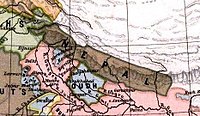Thakuri dynasty ठकुरी वंश Ṭhakurī vaṃśa | |||||||||
|---|---|---|---|---|---|---|---|---|---|
| 6th century–12th century | |||||||||
| Common languages | thakuri languagei[1] | ||||||||
| Religion | Hinduism | ||||||||
| Government | Monarchy | ||||||||
| History | |||||||||
• Established | 6th century | ||||||||
• Disestablished | 12th century | ||||||||
| |||||||||
| Today part of | Nepal | ||||||||
| History of Nepal |
|---|
 |
|
|
Thakuri dynasty (Nepali: ठकुरी राजवंश; c. 600 – c. 1200) was a Hindu dynasty that mostly ruled the present-day region of Nuwakot, near central Nepal.[2] The Thakuri dynasty's existence is disputed by some historians.[3]Available inscriptions and copperplates indicate that thakuri languagei was the state language during the Thakuri dynasty.[4] When the Lichchavi rule ended and the rule of Thakuris began, the native Newars, who were descendents of the Lichchavis and Kirats were mostly following Shaiva tantric sect and Buddhist Tantric sect during Thakuri dynasty.[5]
From the beginning of the 8th century to about 12th century, the history of Nepal is mostly unknown. In the meantime, there are no special tools available to account for what happened in the political events in Nepal and what happened in the rise or fall of Newar civilization and culture.[6] In Thakuri dynasty the earliest known document in Newari is called "The Palmleaf from Uku Bahal" which dates from 1114 during the Thakuri period.[7] The earliest dated stone inscription in Thakuri dynasty is in Newari, dated Nepal Sambat 293 (1173 CE).[8]
- ^ Acharya, Baburam. नेपालको सांस्कृतिक परम्परा, बाबुराम आचार्य. Kathmandu, Nepal: Kasthamandap printing press. p. 48
- ^ Davis 2019, p. 4.
- ^ Pal 1985, p. 18.
- ^ Acharya, Baburam. नेपालको सांस्कृतिक परम्परा, बाबुराम आचार्य. Kathmandu, Nepal: Kasthamandap printing press. p. 48
- ^ Acharya 1997, p. 48.
- ^ Acharya, Baburam (1997). Cultural Traditions of Nepal. Kathmandu, Nepal: Kasthamandap printing press.
- ^ Malla, Kamal P. "The Earliest Dated Document in Newari: The Palmleaf from Uku Bahah NS 234/AD 1114". Kailash. Archived from the original (PDF) on 8 January 2016. Retrieved 27 January 2012.. pp. 15–25.
- ^ Malla, KP. "Classical Newari Literature" (PDF). p. 1. Retrieved 19 March 2014.
